Wire Lines: Cat 5 Cable and Audio
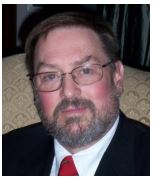
[March 2020] Most engineers think of Cat 5 and Cat 6 cable as useful for data and control, but not audio. Sometimes, the thinking is that the lack of shielding means the cable is not very useful for clean audio. But, as Steve Lampen explains the history of Category cables, you may want to think again.
There was a specific moment when I first thought about the audio performance of “Category” (aka: Cat) data cables.
Moving Beyond Data
That was in 1995, after working for four years at Belden, a wire and cable manufacturer.
I was looking at the lab test results for a new product, tentatively titled “Data X.” The performance was better than any twisted pair cable I had ever seen and I remember saying to another Belden engineer, “This stuff would even make great audio cable.”
I told the marketing folks that, if they called this new product “Data-Anything” (The previous product was Datatwist 350) then only data customers would buy it.
I suggested the name “MediaTiwst,” which was the name they chose in the end. (For what it is worth: another Belden employee claims to have come up with the name. Great minds think alike.)
Not Really So Revolutionary
But, to be honest, I now realize that cable like this had been used to carry audio for decades.
The telephone company (The Bell System and its relatives) had long used the same cable for telephone connections and for audio. This was solid conductor, 24 AWG, twisted pairs. Almost the same as what was in modern Category cables.
Many might remember this Telco cable as POTS (plain old telephone service) wire. This worked great for telephones, with an audio bandwidth of 3.5 kHz (3500 Hz), and was also decent when used for higher quality audio.
When commercial radio started in the 1920’s, telephone twisted pairs were used almost immediately for long lines between sporting events, political conventions, and the control 2 rooms of radio networks or local radio stations. The bandwidth needed for AM use was around 5 kHz. It was the low end that was a bit of a problem and required high quality transformers to get down to 100 Hz.
FM Audio Lines, Too
With the introduction of FM radio, the audio quality needed jumped to a bandwidth of 50 Hz to 15 kHz.
By then amplifiers and equalizers were used to assure the audio quality over very long distances, and the demand for these twisted pairs was a major source of income for telephone companies around the world. They became the de facto standard for studio to transmitter links (STLs).
Still, as a user of these twisted pairs, you had to test them to be sure they were in phase, at the same level, with the same signal-to-noise level, and with reasonably low distortion. If something went wrong, every studio and every transmitter site had the phone number of the local telco Central Office and most broadcast engineers were on a first-name basis with their brothers in wire at the local telco facility.
Better Cat Cables
It was only with the advent of computer data that the limitations of POTS pairs became apparent.
Telcos all quietly changed the parameters so that all of their copper wiring was Category 3 or better, so that they could run data on those pairs. This kept Cat 3 alive long after it was abandoned by the computer network folks. And the cost differential between Cat 3, Cat 4, and Cat 5 became so small that by the end of the 1990s, every copper telco installation was on Category 5 cable.
Go check the copper cable coming into you building or home if you do not believe me – if it is still copper and not yet fiber optic cable, it is very old.
Twist and Shout
One funny story was the twisting of the pairs in Category 3 cable.
There was really only one way to design the cable. Twist and measure, then do a different twist and measure again – and so on for weeks or months. Along the way, look at the relationship between the pairs, such as crosstalk between pairs. At the end of this laborious process, you would select the pairs with the best performance.
But, if one pair was very tightly twisted, and another very loosely twisted, the crosstalk would be fantastic, but the delivery time (the “delay skew”) would be horrible. (The tight pair would take much longer to deliver a signal than the loose pair.) In the data world, this only popped up with Category 5e which allows the data to be split between the four pair and combined at the other end.
The delay skew had to be very close to the next pair or the chip could not line up the data and put it back together.
But back at the beginning of Cat 3, nobody thought about this and just twisted the pairs in four different ways and threw those four pairs together. Some cables were good, some were very good, and some were horrible in crosstalk.
The AT&T Solution
The “mother ship” of data and telephone service – AT&T – thought they had an even better way.
They determined the range of what could reasonably be made and fed those numbers in to a Cray super computer. They just asked for the four pair twists (“lay length”) that would give them the lowest crosstalk. Two weeks and $10 million later, they had their four numbers.
Then a funny thing happened. Everybody who made cable could get a piece of this AT&T cable, measure it, and make a pretty good copy of those four numbers. (Testing would show how close you could get.) So all of the Cat 3 cables were very close in performance.
However, the bandwidth on Cat 3 was only 16 MHz (based on the same bandwidth for IBM Token Ring systems which predated Category cables.) When Cat 4 came out (20 MHz) and then Cat 5 (100 MHz), there was no computer on earth that could generate those four numbers. And everyone was back to twist and measure, twist and measure, twist and measure.
That was 30 years ago, and computers have come a long way. Now we are into data cables such as Category 6A with a bandwidth of 10 GHz. Are there computers who could calculate that? Nobody is talking! The result is that if you ask, you will get a strong “no comment!” from anyone who seriously manufactures data cables.
Back to Our Theme
But, boy, have I gotten way off the subject of “Cat 5 and Audio.”
Well, not really because all of the improvements made to data cables applied, to greater or lesser degree, to its audio performance. After all, any cable really only has three absolute parameters: resistance (R), capacitance C and inductance (L). The combination of all of these generates a fourth number called impedance (Z).
Sure there are other numbers, but many of them are related (or can be affected by) these three/four basic parameters.
Now I could fill the next hundred pages with how these work so if you are truly interested put those four words in Google and I am sure you will have enough reading material for the next decade.
Analyzing the Tests
Let us return to those 1995 lab test results for MediaTwist (Belden 1872A) that really blew me away.
Over the years, there were dozens of improvements on the cable design and manufacturing processes, some of which are trade secrets so even now (as an ex-employee) I cannot talk about.
Nevertheless, one major improvement was bonded pairs, where the two wires are stuck together (without glue). The spacing between the two wires is a key part in capacitance of that pair and also in the impedance of that pair.
Bonded pairs approach the impedance stability of coaxial cable, which is best of all. Bonded pairs also have the lowest emission from any pair, so the crosstalk is already excellent. If you know about “balanced lines” which is how most professional audio is sent down cable, you will understand that the balance (CMRR, common mode rejection ratio) is the best of any twisted pair.
Just Slightly Larger
Additionally, MediaTwist was the first cable to use 23 AWG wires.
Data cables up to that point were 24 AWG, like the POTS cable mentioned earlier. 23 AWG will still fit into a data connector (RJ-45) and was just a little bigger, with lower resistance and lower resistive loss. This cable was the first cable to meet many of the European shielded cable requirements – without being shielded.
As far as I know, the cable is still sitting in “limbo” in the European standards organization.
And there have been even more improvements since then.
There were more than a few installers who went with these data cables as audio cable because they too recognized the improvements that had been made. One recording engineer, made these cables his standard for all his classical location recording around the world, with the most expensive microphones attached.
But there was a problem.
Dealing with XLR Needs
If you are soldering wires in place, it is no problem to use these data cables.
Figure 1 shows a patch panel wired up with soldered data cable.
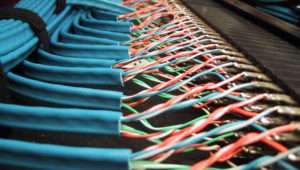
Figure 1 – Cat 5 soldered in place
The four color combinations of the pairs, intended for RJ-45 data connector wiring, actually help to assure the order of the pairs when they are attached for audio. At the same time, it is clear that putting the wiring into four XLR connectors would not be so neat.
A solution came from a number of companies that make adaptor boxes to convert these four pairs into four XLR connectors. Figure 2 shows one of these.
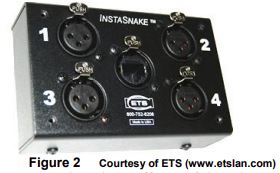
Yet, no sooner do I show off one of these boxes then someone says, “Wait a minute! Those pairs aren’t even shielded. What’s the crosstalk at audio frequencies?” What a great question!
And since data cable specs do not begin until 1 MHz for crosstalk, I did not know. So I asked the lab (back in 1995) to show me the crosstalk at audio frequencies. And the cable I picked for this test was the worst cable I could find: Belden 1752A, which is stranded 24 AWG, Category 5e patch cable, meant for short distances only.
Here were the results:
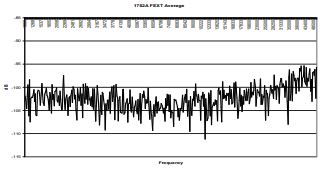
This graph shows the bandwidth from 1,000 Hz to 50 kHz (50,000 Hz). You will notice that the worst number is slightly more than 95 dB crosstalk at 43 kHz (way beyond audio). This is called FEXT in the data world (far-end crosstalk), looking at the end of the cable where the signals are weakest.
“Hold on!” said my engineering friends. “What we really want to see is where the signals are strongest, NEXT (near-end crosstalk).” So here is the same cable with the NEXT measured:
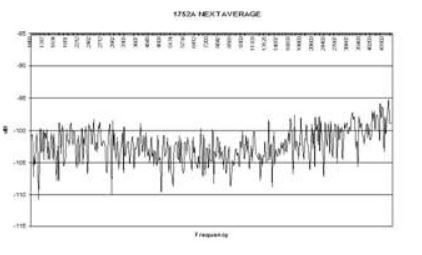
Well, as it turns out, the measurements are even better. The worst case -95 dB is just about 50 kHz and, like the other graph, most of the time the crosstalk in -100 dB or even better.
And this was patch cable! What if the lab measured MediaTwist? So I asked them.
After weeks, the lab technician called me crying on the phone. “We’ve been trying to read the crosstalk of MediaTwist but we can’t. It’s below the noise floor of the Network Analyzer.” By the way, the noise floor of the $60,000 H-P Network Analyzer is -110 dB, so good cable is below that.
Did it measure -120 dB or -130 dB? Sorry, I do not know.
Standards
So the truth is that all Category cables are made to a standard. As long as they meet the standard for data, they should be very good, sometimes excellent, for audio.
But here are the “gotchas” from using these cables for audio:
- These Category cables work with balanced signals only.
- The better the balance (CMRR), the better everything works – including the cable.
- Unshielded cable works fine with excellent crosstalk performance.
- Good crosstalk (-100 dB) means you can mix line level (+4 dBm or +8 dBm) with microphone level signals (-50 dBm ot – 60 dBm) on adjacent pairs.
- If you need to support “phantom powered” microphone, you will need to use shielded data cable (there are two other ways to use data cable and phantom power – send me an email).
- If you would like a sample of cable to test in your lab, send me an email: steve.lampen@belden.com as I still have skin in the Belden game.
– – –
Steve Lampen is now retired after 28 years with Belden, however he still does work as a consultant and author. Steve welcomes your comments.
